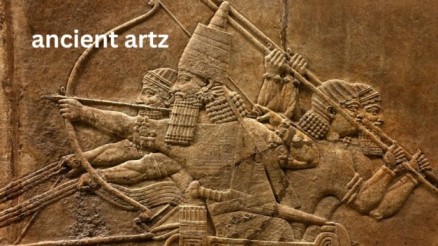Discover the Timeless Beauty of Ancient Artz Across Cultures
Welcome, art enthusiasts and history buffs! Today, we’re diving into the fascinating world of ancient artz a treasure trove of creativity, culture, and spirituality. Whether you’re a seasoned art lover or a curious learner, this post will walk you through the key characteristics, purpose, and impact of ancient artistic expressions from various civilizations.
Let’s explore how ancient artz shaped the world we live in today, and why it still resonates with us, centuries later!
Introduction to Ancient Artz
What is Ancient Artz?
Ancient artz refers to the visual creations made by civilizations thousands of years ago. It includes everything from sculptures and paintings to pottery and jewelry. These artworks were deeply connected to the cultures, religions, and daily lives of the people who created them. Think of them as windows into the past, offering us a glimpse into how ancient societies saw the world and their place in it.
Why is Ancient Artz Important?
Ancient artz isn’t just about pretty pictures, it’s about understanding history. It reflects how people lived, what they valued, and what they believed. In fact, ancient artz has played a crucial role in preserving the spiritual, political, and cultural history of early civilizations. By studying it, we gain insight into how past societies shaped the present and how creativity transcends time.
Key Characteristics of Ancient Artz
Ancient artz is diverse, but there are some common themes and styles that appear across different civilizations. Let’s explore some of the most notable characteristics.
Geometric Patterns and Designs
Many ancient artworks feature intricate geometric shapes and patterns, especially in early civilizations like the Greeks and Mesoamericans. These patterns weren’t just decorative, they had deeper meanings. In ancient Greek art, for example, geometric patterns symbolized balance and harmony, reflecting the order of the universe.
In cultures like the Mayans and Aztecs, geometric designs often appeared in pottery and architecture, symbolizing the connection between the earth, the cosmos, and the divine.
Animal Themes in Ancient Artz
Animals played a significant role in ancient artz, often carrying spiritual or symbolic meanings. In Ancient Egypt, animals like lions and falcons were associated with powerful gods. For instance, the sphinx—a creature with the body of a lion and the head of a pharaoh symbolize strength and wisdom.
Similarly, in Mesoamerican cultures, animals were often featured in art to represent the natural world’s power, from jaguars to serpents. These animal motifs bridged the gap between the human and supernatural worlds, adding layers of meaning to the ancient artz.
Depictions of Gods and Goddesses
One of the most defining features of ancient artz is the depiction of deities. Ancient artists didn’t just create representations of gods, they made them larger than life. Whether it was the towering statues of Greek gods like Zeus or the detailed reliefs of Egyptian pharaohs as gods, these artworks communicated the divine power and significance of the figures.
In Roman art, gods were often depicted in realistic ways, showcasing human emotions and flaws, which added a relatable quality to their divine nature. The portrayal of gods and goddesses was a direct reflection of each culture’s religious beliefs and their understanding of the divine.
Use of Abstract Designs
While many ancient artz works were highly symbolic, others leaned into abstraction. Artists often simplified complex forms into basic shapes, focusing on communicating spiritual concepts or ideals rather than literal representation. For example, in Egyptian art, human figures were often shown in profile with a mix of realism and abstraction to emphasize the soul’s eternal nature, not just the physical body.
Realism vs. Symbolism in Artistic Expression
Ancient artz didn’t always aim for lifelike realism. Instead, artists often emphasized symbolic representation. This means that instead of capturing an exact physical likeness, they focused on conveying deeper meanings. For instance, a painting or sculpture might highlight certain features of a person, like their posture or expression, to reflect their social status or divine connection, rather than aiming for precise accuracy.
The Purpose of Ancient Artz
Art wasn’t just about creating beautiful objects. For ancient societies, it had deeper, more meaningful purposes.
Spiritual Significance
In many ancient cultures, ancient artz served as a tool to express spirituality. Artworks were often used in religious rituals and ceremonies, serving as offerings to gods or as symbols of divine power. For example, Egyptian tomb art was designed to guide the soul of the deceased to the afterlife, ensuring their eternal peace.
Communication with the Divine
Ancient artz wasn’t just about portraying gods, it was a way for people to communicate with them. Through sacred symbols, rituals, and prayers depicted in art, individuals sought favor or guidance from the divine. This sacred purpose made art a key element in religious and cultural life.
Documentation of Cultural Narratives
Art also served as a powerful storytelling tool. From murals depicting historical events to sculptures celebrating great leaders, ancient artz was a way to document important cultural narratives. It helped people record their history, pass on their traditions, and preserve the stories of their ancestors.
Exploring Different Civilizations
Ancient artz varies greatly across different cultures, each with its own unique styles and techniques. Let’s take a look at a few of the most prominent civilizations known for their artistic contributions.
Egyptian Art
Egyptian art is instantly recognizable for its bold, stylized forms. It was deeply tied to religion and the afterlife. The famous pyramids, along with the elaborate tomb paintings and sculptures, were all created to honor gods and pharaohs. Egyptian art is filled with symbols, and everything from the way figures were positioned to the colors used had a specific meaning.
Greek Art
Greek art is known for its pursuit of realism and humanism. From the graceful sculptures of gods and athletes to the architectural wonders like the Parthenon, Greek artists sought to represent the human form in its most idealized state. Their art was a reflection of their belief in the balance of mind, body, and spirit.
Roman Art
Roman art took inspiration from the Greeks but was more focused on practical applications. It included realistic portraits of emperors and citizens, as well as detailed depictions of everyday life. Roman art often sought to capture the individual’s likeness and convey their personality, making it a blend of realism and idealization.
Mesoamerican Art
Mesoamerican cultures like the Maya and Aztecs created ancient artz that was heavily symbolic. They used vivid colors and intricate carvings to tell stories of gods, nature, and the cosmos. Mesoamerican art often adorned temples, pyramids, and public spaces, where it could be seen by large audiences.
Analyzing Specific Works
Famous Artworks and Artifacts
When looking at specific ancient artz pieces, such as the Venus de Milo (Greek sculpture) or the Mask of the Red Queen (Maya artifact), we get a deeper understanding of how art reflects the culture that produced it. These pieces, and others like them, offer rich insights into ancient beliefs, customs, and technical prowess.
Historical Context and Symbolism
Every piece of ancient artz has a story to tell. Understanding the historical context helps us decode the symbolism behind each piece. For example, the Mayan tomb paintings aren’t just colorful images; they reveal spiritual beliefs about the afterlife, honoring the ancestors, and celebrating cosmic cycles.
Artistic Techniques Used
Ancient artz artists used various techniques, such as fresco painting, stone carving, and metalworking. Understanding these methods helps us appreciate the skill and dedication involved in creating the art we admire today.
Connecting Art to Culture
Reflection of Societal Values and Beliefs
Ancient artz is a mirror of the values and beliefs of the cultures that created it. For example, Egyptian art often focused on life after death, reflecting the civilization’s deep connection to the afterlife and the gods. Meanwhile, Greek art highlighted beauty, balance, and the pursuit of knowledge.
Daily Life Depicted in Ancient Artz
Ancient artz didn’t just focus on the divine, it also showed the daily lives of ordinary people. Whether it was the depiction of a Roman banquet or a worker in a Mesopotamian relief, art offered a glimpse into the everyday activities and social structures of ancient societies.
Engaging Visuals
Importance of Visuals in Enhancing Content
Including visuals, like images of ancient artz, can help bring your content to life. Pictures help readers connect with the topics you’re discussing, making it easier to understand complex concepts and appreciate the beauty of the works you’re describing.
Suggested Images to Include
Think of iconic pieces like the Egyptian pyramids, Greek vases, or the Mayan stelae. Including these images in your content will enhance the reader’s experience and deepen their understanding of ancient artz.
Encouraging Discussion
Inviting Reader Engagement
Ancient artz has been around for thousands of years, but its significance continues to spark conversation. Invite your readers to share their thoughts on how ancient artz influenced modern culture, or how they interpret certain famous pieces. Discussion can lead to new perspectives and further enrich the topic.
Also Read: The Blogs Valley
Conclusion
Recap of the Significance of Ancient Artz
Ancient artz is more than just a collection of old paintings and sculptures it’s a key to understanding our past. Through these artworks, we can learn about the beliefs, daily lives, and values of long-gone civilizations. They are living records of history that continue to inspire and inform us today.
FAQs About Ancient Artz
1. What is ancient artz?
Answer: Ancient artz refers to the artistic expressions created by various civilizations throughout history, characterized by unique styles, themes, and purposes. It includes a wide range of mediums such as sculptures, paintings, pottery, and textiles that reflect the cultural, spiritual, and social values of the societies that produced them.
2. What are some key characteristics of ancient art?
Answer: Key characteristics of ancient art include geometric patterns, depictions of animals, representations of gods and goddesses, abstract designs, and a balance between realism and symbolism. These elements often served to convey deeper meanings related to spirituality, nature, and cultural narratives.
3. Why was ancient art created?
Answer: Ancient art was primarily created for spiritual purposes, serving as a means to communicate with the divine and express reverence for gods. It also functioned to document cultural narratives, convey societal values, and play a role in rituals and religious ceremonies.
4. How does ancient art differ between civilizations?
Answer: Ancient art varies significantly between civilizations due to differences in cultural beliefs, social structures, and artistic techniques. For example, Egyptian art is known for its iconic representations of pharaohs and deities with strict adherence to formality, while Greek art emphasizes realism and human emotion in its sculptures.
5. What is the significance of studying ancient artz today?
Answer: Studying ancient artz is significant because it provides insights into the values, beliefs, and daily life of past civilizations. It helps us understand the evolution of artistic practices over time and how they continue to influence modern art. Additionally, ancient artworks serve as a testament to human creativity and cultural heritage that enrich our understanding of history.


